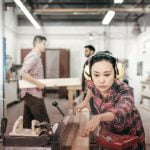Introduction
Woodworking is an enjoyable and rewarding craft. People all over the world enjoy woodworking for its ability to create beautiful pieces of furniture, crafts, and other home goods. But woodworking also comes with risks if safety precautions aren’t taken, so it’s important to understand how to keep yourself safe as you work with these materials. Several safety measures should be considered before, during, and after a woodworking project.
Before beginning any project, make sure you have the right personal protective equipment such as glasses or goggles, ear protection, a dust mask and gloves. Also check all power tools for any faulty parts or blades that may need replacing. Make sure to use the appropriate cutting tools for your specific material; blades or bits chosen incorrectly can cause kickbacks or breakage that could cause injury. Additionally, take necessary safety steps such as disconnecting power tools from their power source when not in use or keeping cords out of away from walkways, preventing tripping hazards and injuries from moving blades on saws.
When working with dust-producing materials, ensure proper ventilation is available to reduce inhalation of particles that can be extremely damaging to your health in the long run. Keep a fire extinguisher in close proximity at all times just in case of fire; consider also investing in a spark guard shield around any dangerous machines that could kick up sparks in the event of an accident. Finally set up an adequate clean-up system consisting of collection bags for small particles like shavings and good air filtration systems suitable for larger debris like sawdust so it doesn’t linger. Taking these steps can help prevent accidents from occurring throughout your woodworking endeavors!
Essential Safety Gear to Wear and How to Choose It
When it comes to woodworking, safety should always be the top priority. It is important to always wear the right safety gear, including eye protection, gloves, and ear protection. Eye protection is essential for any woodworker as sawdust or chips can fly off the wood and into your eyes. Choose impact-resistant glasses, preferably with polycarbonate lenses. Goggles are recommended when working with power tools as this type of eye wear offers a snug fit and full face coverage.
Gloves can also be very important for woodworking as they protect hands from splinters and dust. Choose gloves that have a snug fit, are non slippery and flexible so you can maneuver accurately and have ample dexterity when using tools. They should also provide protection from both heat (for dealing with hot glue guns) and cuts (from sharp objects). For ears, it’s important to invest in a good pair of protective ear muffs or ear plugs to block out loud noises from some of the more powerful machines used in woodworking projects. These devices should be comfortable yet stay securely on your head while working on any project.
Safeguards for Furniture and Equipment and How to Install Them
When it comes to woodworking, safety precautions should always be taken. There are a variety of safeguards you can install to help reduce the risk of accidents.
Eye protection is essential especially when using power tools such as routers, saws or sanders. Choose wooden frames that are well constructed and fit snugly around the face. It is also important to wear hearing protection as loud noises associated with some tools can result in ear damage if not properly protected.
To protect your hands from getting nicked or cut, make sure you wear gloves with good gripping ability, preferably ones made from Kevlar or leather. Avoid loose clothing and ensure long hair is tied up securely. Safety glasses should be worn for additional protection for face and eyes when using hand-held power tools and chisels.
Dust masks should also be worn when dust particles are created to avoid inhaling wood particles which could potentially cause asthma or other respiratory illnesses. If a lot of dust is being produced when working, consider wearing an appropriate respirator and abide by any regulations supplied by the manufacturer.
Make sure all machinery is stable and safe to use before operating it, inspect it regularly for faulty components or broken parts that need repairing or replacing before continuing your work operations. Unplug machines during tool changes and repairs to prevent accidental start-up while performing maintenance tasks. Furthermore, provide adequate ventilation in the work area where solvents are used such as paints, lacquers and stains and never use them near sources of heat or lit flames such as gas fires or hotplates/cookers . Lastly keep your workshop clean by frequently clearing away scrap materials such as swarf from saws etc., sweeping away any sawdust build up on floors etc.. This will create a safer environment while working making less likely slips, trips ore falls occurring in an already hazardous area due to general workshop housekeeping not taking place
Fire and Explosion Prevention in the Workshop
One of the most important safety precautions to take when working with wood is to prevent fires and explosions from occurring. It’s important to always wear eye protection and a face shield, as well as clothing that covers your arms and legs to protect you from sparks and flying debris. Make sure that any combustible materials are kept away from potential sources of ignition. Keep tools and machines in good condition – faulty tools or equipment can create sparks that can ignite wood dust and other combustible materials around the workshop.
It’s also important to consider ventilation when woodworking. There must be proper air flow in the workspace, ideally with a combination of natural ventilation (air moving through open windows, doors, or other openings) and mechanical ventilation (fans, extractors, etc.), in order to disperse sawdust and exhaust fumes safely into the atmosphere outside. Ensure all power tools in the workshop have emergency stop switches connected directly to them so they can be stopped quickly should an emergency arise. Regularly clean up sawdust from power tooling operations; sawdust is highly flammable! Finally, keep a fire extinguisher nearby at all times for fast response if needed.
Sharp Tools and Other Equipment Safety
When working with sharp tools and other equipment when woodworking, it is important to take the necessary safety precautions to avoid any potential injuries. Here are some tips and techniques for reducing the risk of potential injuries:
1. Always wear eye protection and a face mask when working with sharp tools and other equipment. This will help protect your eyes from flying debris.
2. Ensure that your work area is clear of clutter and well-lit so you can keep track of where every piece is at all times.
3. If you are using a power tool, make sure it is plugged into a ground fault circuit interrupter outlet in order to protect against shock hazards in case of an electrical short circuit or surge.
4. Never start or use a machine until you are familiar with its proper operations and safety features, such as emergency shut-off switches or overload indicators (if applicable).
5. Keep your hands away from moving parts at all times while operating something like a table saw or drill compression bit.
6. Ensure that blades and routing bits are securely attached on all pieces of equipment before use, and replace if overly worn or damaged in any way; never attempt to make repaired blades work if they are in poor condition as this could cause potential injury.
7. Be sure to unplug the equipment before attempting to adjust any pieces or settings on the machine; failure to do this could easily result in injury from an unexpected release of energy stored in the system’s capacitors due to suddenly being switched off without warning during adjustment periods on certain types of machines like routers or sanders.
Keeping Children Safe
When it comes to woodworking, one of the most important practices is taking safety precautions. In order to keep children safe in the workshop, there are several tips and guidelines that need to be followed.
First, it’s important to always use the right tools for the job. Make sure power tools have their own dedicated extension cords and keep all stored away when they are not in use. Second, protect fingers and toes away from cutters, blades, and saw blades by always using push sticks or guards before attempting a cut. Third, ensure ventilation is optimal throughout the workspace area so as not to cause any potential harm with dust particles or chemical fumes. Fourth, keep all potentially hazardous materials such as thinners and paint removers locked away from curious hands or eyes. And finally, provide proper adult supervision anytime a child is working in or around a workshop.
By adhering to these simple tips and guidelines for children’s safety in the woodworking workshop you will help create a safer experience for everyone involved!
First Aid Supplies and Procedures
Having the necessary supplies and procedures on hand for treating any potential injuries that may occur in a woodworking shop is essential. It’s important to keep a fully supplied first aid kit nearby and familiarize oneself with how to properly use it. Items such as bandages, hydrogen peroxide, gauze, medical tape, antiseptic creams and sterile gloves should be present in the kit so that any minor cuts or abrasions can be treated properly. Additionally, a good knowledge of basic treatments for burns, lacerations and more serious conditions should also be possessed by anyone working in a woodworking shop. In case of an emergency situation, it’s paramount to have quick access to local emergency services by calling 911. Furthermore, workers should know how to handle objects that could cause injury without putting themselves at risk and be aware of the risks associated with wood dust particles which have been linked to respiratory illnesses such as asthma or other breathing problems. Taking good safety precautions when working with sharp tools is also very important. All bladed tools should be kept sharpened, secured when not in use and well-maintained so as to minimize slips or incidents when being used on materials or machines.
Other Important Safety Considerations
When working in a woodworking space, it is important to make sure the area is free of any objects that could cause injury. Floor surfaces should be clear of any trip hazards, such as power cords and tools in the walkway. Protective items such as safety glasses or respirators should be worn when appropriate. Furniture should also be evaluated for potential pinch points that cause harm during operation or adjustment. Additionally, operators working with powered machines must always wear approved hearing protection due to potential noise levels. Finally, when operating machinery without a dust collecting system, a respiratory mask is advised to help prevent inhalation of sawdust particles from entering the lungs.
Conclusion
Woodworking is a great way to bring creativity and craftsmanship into your home. You can make furniture, decorations, and useful items with just the right tools and knowledge. However, it’s important to remember that woodworking involves working with sharp tools and power equipment. While these tools can be used safely if proper precautions are taken, it’s imperative for everyone to understand their potential dangers before getting started. Wearing the appropriate safety gear, using caution with machinery, keeping things organized, understanding tool uses, ensuring good lighting conditions, and being aware of your surroundings are all key components of safe woodworking.
It’s also important to be realistic about the capabilities of yourself and others in the workshop. With inexperienced workers or children around the shop or workspace, it’s necessary to offer additional safety guidance. Establishing rules regarding wearing protective eyewear and hearing protection when working alongside machines is a great first step towards avoiding injury. If anyone has questions about how to operate any equipment or tools confidently and safely, an experienced supervisor should be made available to direct them throughout their interactions in the workshop.
Safety should be a top priority when engaging in woodworking projects at home or in a professional setting—without taking these measures seriously you may run the risk of serious injury or even death due to mishandling of these machines and tools. Taking heed of safety materials created by experienced woodworkers as well as heeding advice from more experienced colleagues will help ensure not only your own well-being but those around you too when engaged in any type of carpentry task that requires specialized machinery or handwork with extremely sharp objects such as saws or planes. Ultimately prioritizing safety through common sense practices will help minimize the risk of injuries when engaging in any activity involving dangerous tools or machines for creative carpentry work!

Hi everyone! I’m a woodworker and blogger, and this is my woodworking blog. In my blog, I share tips and tricks for woodworkers of all skill levels, as well as project ideas that you can try yourself.





